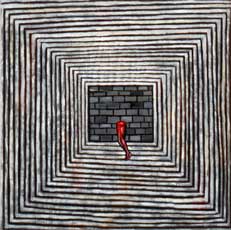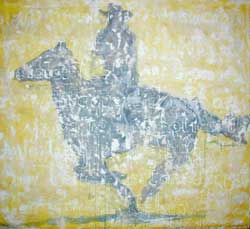
Azaceta, Charbonnet & Chihuly
by Thomasine Bartlett, THE NEW ORLEANS ART REVIEW
The December Show at Arthur Roger Gallery features the work of Luis Cruz Azaceta, Nicole Charbonnet and an installation by Dale Chihuly. The large front gallery is given over to the work of Azaceta. The work is very varied, ranging from drawings – even on brown paper bags – to collage paintings, to wall-hung wood constructions, chromogenic prints on wood and free-standing sculpture. Generally quite colorful, somber titles such as Threat and Intruder contrast with the imagery.

Luis Cruz Azaceta: Blocked, 1999
The title of the show is “Happy-Deadly in New Orleans.” These works are a part of Azaceta’s on-going exploration of urban violence and terrorism. Utilizing a system of personal symbolism within the context of abstraction, Azaceta employs contradictions of imagery and representation to underscore the meaning of his work. A native of Cuba who immigrated to the United States in 1960 just after the revolution that brought Castro to power, Azaceta has been increasingly concerned with terrorism in his work since the tragedy of 9/11.
Figures appear in many of Azaceta’s pieces; the figures are generally diminutive and almost lost in the surrounding imagery. In Threat, for example, a tiny, nude figure and a blue ball are situated in an abstract, striped corridor in the center of a larger, abstract, striped space. It is maze-like and frightening; the figure has his arms protectively wrapped around his body. Several of the works include stuffed animals. These stuffed animals are wired, often to clocks, and appear to be bombs awaiting the appropriate time to detonate. Hunter utilizes a small stuffed elephant and a rat trap; Involuntary Kamikaze includes a stuffed pig, and Captive I (TV), features a stuffed Mickey Mouse. The contrast of the innocence of toys appropriate for the youngest of children and the images of terrorism is disquieting and a bit unnerving.
In sharp contrast to these works by Azaceta are the works of Nicole Charbonnet. Charbonnet’s four large paintings, collectively titled “Tell the Truth but Ride a Fast Horse,” are displayed in the center gallery, bridging the space between the terrorism of Azaceta and the fragile, graceful glass of the Chihuly installation. Charbonnet’s paintings are concerned with the collective memory of America — with the memory of who and what we are. This particular group of paintings draws on classic Westerns — the movies of memory. Each painting features horses; some are the horses on their own, while others show the horses with their cowboys.

Nicole Charbonnet: Cowboy #21, 2004
The paintings are built in layers of overlapping imagery, although each final image is an integrated picture of mounted cowboys or horses. The process, however, of reaching this finished image is revealed in Charbonnet’s work. It is this revealed process that makes these images unique and interesting, and rescues them from what could appear to be tired reiterations of Remington. The process is one of layering — like the building of memories, and the layers are integral to the meaning of the paintings. Read through the final images of mounted cowboys are flowers, words, phrases and what almost — but not quite — appears to be lines of not-quite-legible poetry. For Charbonnet, the process of painting serves as a metaphor for memory. She superimposes texture, text, washes of chalky paint, veils of translucent fabric and paper to build up the structure behind the images. The colors are soft, the lines brushy and sketchy — details fade into the painterly structure of the underlayers. The paint runs and drips into the borders, or messy painterly-ness leaks onto the outer edges of the canvas. Underlayers are sometimes completely exposed, sometimes partially covered and sometimes completely subsumed by subsequent layers. The paintings themselves evoke the process of memory.
The juxtaposition of Azaceta’s terrorist imagery and Charbonnet’s American memory paintings is interesting. Both artists are concerned with the collective of America – whether that be as victims of terrorism or as individual agents participating in culture. In either case, it is America that is being considered, evaluated and depicted. In both cases it appears that this consideration is both a record of past and present and a look toward an unknown future that culture cannot help but continue to shape.
